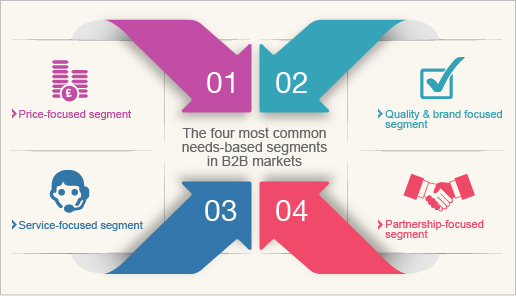Market segmentation is a
fundamental concept in identifying profitable business opportunities.
Market segmentation divides markets into subsets of consumers or businesses who
share a similar set of needs and wants, evaluating the subset segments, and
then implementing strategies to target high value segments.
Segmentation is widely used in consumer
marketing. This becomes very obvious walking down the aisles of your local
supermarket seeing product form segmentation such as liquid laundry detergent
or powder, special shaving products for African American men, or easy to
prepare food products targeted to the working parent.
In sharp contrast is business to business (B2B)
where recent research shows limited use of market segmentation and where it is
used, little value is received. It may be that segmenting business markets is
more complex than consumer markets because business to business marketing is
much more than a simplistic approach of finding customers who may be interested
in your product.
Historically, B2B was viewed as the
segmentation between the seller and buyer using a variety of segmentation bases
including demographics, sometimes called firmographics, operating variables,
purchasing approaches, situational factors, and buyers’ personal
characteristics. Simply, whoever bought from you was the focus of the
segmentation analysis.
Today, B2B marketers recognize there are
situations where the company buying your product is not the ultimate user or
consumer. So, segmentation is more than just B2B. At times it is B2B2B or even
B2B2C (consumer), thus segmentation requires a different approach.
B2B
B2B in its simplest form is when a business
sells its products to another business who uses the product themselves.
For example, B2B is selling commercial dishwashers directly to
restaurants. The restaurant market may be segmented by large restaurants
or hotels depending on segmentation criteria. Based on analysis, the
commercial dishwasher company decides to focus sales on restaurants with
seating capacity of at least 150 people.
This is not to be confused where a business
sells products to business intermediaries who resell the product. When Coca
Cola sells soft drinks to Wal-Mart, Coca Cola segments the market on the basis
of consumer use of soft drinks and uses the B2B intermediary as a channel of
distribution. However, Coca Cola may also segment the carbonated drink market
by outlet type, food stores, drug stores, mass merchandisers, small grocery
stores, convenience stores, and other outlet types.
B2B2B & B2B2C
But what happens when a business sells its
product to a business customer and that customer incorporates the product into
its own product for resale to either another business or to consumers? Does the
segmentation method change? Do they look at segmentation differently? Do
they attempt to segment the market on the basis of their customer or do they
also look at the business segments of their customers?
B2B2B
Several examples can help clarify this. XYZ
Company manufactures electric motors. Electric motors have widespread
application for use in other companies’ products. They are used as components
in elevators, escalators, water pumps, oil industry pumps, even electric motors
for aircraft. XYZ segments the market not on the customer purchasing
their product as a component first, but rather on the application of XYZ’s
capabilities. They develop segmentation criteria for different industries using
pumps taking into consideration their own capabilities and strategy. Once
they determine that the market for elevator motors and aircraft electric motors
are growing but oil industry pumps and water pumps are not, they then focus on
segmenting the suppliers to these industries. In essence, the demand for
their products is derived from the demand of their customers’ products.
B2B2C
This is also evident in the high technology
industry. Chip makers sell to Apple, Lenovo, Compaq, HP, Samsung, and Dell, for
use in consumer products such as cell phones, computers, and tablets and now
smart televisions. Consumer behavior drives demand for these products.
So, a chip maker must understand their customer’s customer. A chip maker will
also sell chips to companies for application for cloud computing such as
Dropbox, Amazon, and HP Enterprises. The sales for the cloud businesses
of Dropbox, Amazon, and HP Enterprises are driven in part by consumer demand
for cloud storage or cloud applications. Companies in the B2B2C business must
develop segmentation skills in the consumer market such as psychographic and
behavioral bases for segmentation. Thus, additional segmentation skills are
required beyond the B2B segmentation skills for B2B2C companies.
In a recent report to analysts, Intel revealed
they are reducing investment spending in software, personal computers, and
phones and tablets while investing more in data centers with cloud computing,
retail solutions, transportation and automotive, smart homes and buildings, and
industrial and energy. These are consumer driven segments. They will then focus
on companies who are strong in the growth segments they identified.
Qualcomm similarly looks at the end user of
their customers in deciding product developments, sales, and marketing
priorities. They have identified segments where consumers drive demand
including technology for the automotive market, smart homes, mobile computing,
and wearables.
Segmenting business markets is no longer just looking at your company’s customers or potential customers. With the
recognition of B2B2B and B2B2C, segmentation is now focusing on the market
segments served by the customers to drive investments in product development,
sales, and marketing effort.
* Herb Brotspies is an Adjunct Professor of Marketing (Retired) at Nova Southeastern University. For further information, contact Dr. Brotspies at hvb95@aol.com or (561) 302-3060.









